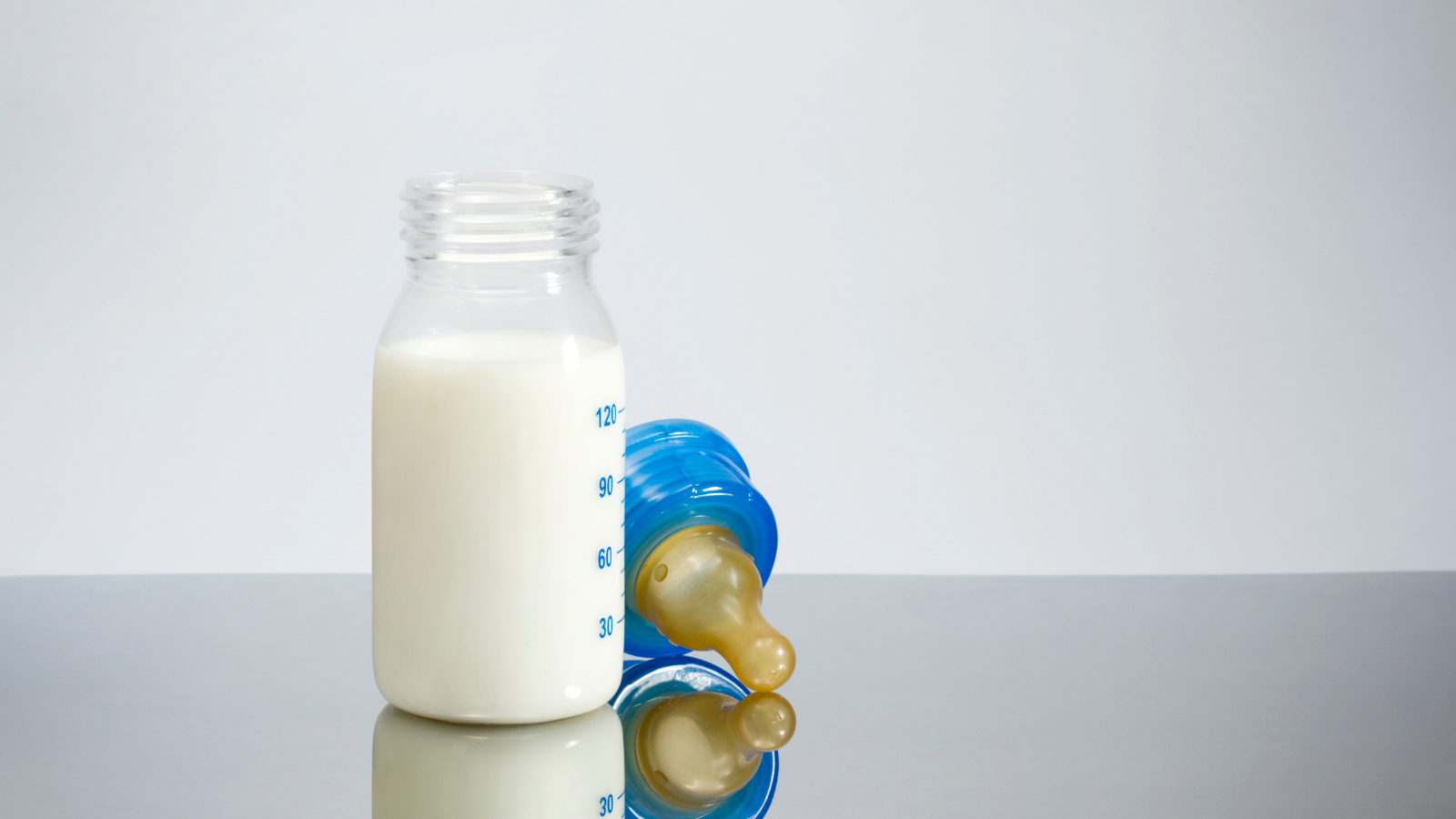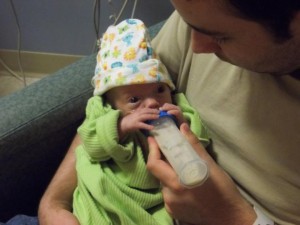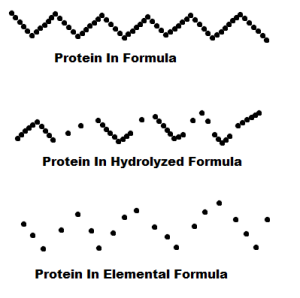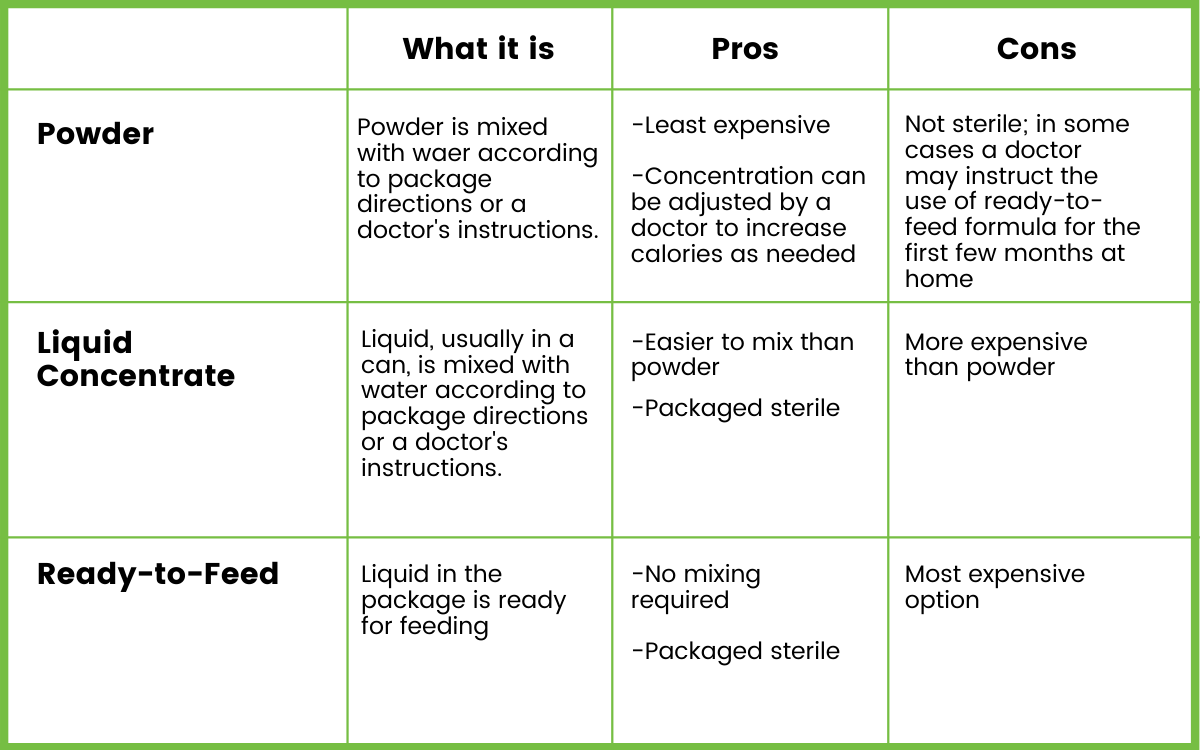
This article has been updated and reviewed for accuracy by Trish Ringley, RN.

Hurray! NICU discharge day is around the corner! As you prepare to take your preemie home, you may walk down the infant formula aisle for the first time. The aisle is overwhelming. There are so many brands, types and choices. Where does one begin?
If you feel or have felt like this, don’t panic. Here we’ll answer some of the most frequently asked questions about infant formula. Hopefully, after reading this, you will feel more knowledgeable and confident about feeding your preemie at home.
What different types of infant formula are available?
- Cow’s Milk-Based Formulas: Cow’s milk-based formula is what the majority of formula fed babies consume. Cow’s milk is adapted and made as close to breast milk as possible, giving it the proper balance of nutrients. Subtle differences exist between some cow’s milk-based formulas on the market. For example, protein content may vary from predominantly casein to predominantly whey to 100% whey. Some formula brands may also offer partially hydrolyzed (broken-down) proteins or reduced lactose formulas. Many babies do well on cow’s milk-based formulas, but some babies may be allergic to the proteins in cow’s milk and benefit from a different type of formula.
- Soy Formulas: Soy formula uses processed soybeans as its source of protein. Soy formulas may be an option for babies who require a strict lactose free diet or for vegetarian families. It’s important to note that soy formulas are not recommended for preemies due to risk of osteopenia (brittle bones). Additionally, babies that are allergic to cow’s milk formula may also be allergic to soy formula.
 Hydrolyzed Formulas: Hydrolyzed formulas are for babies with allergies to cow’s milk proteins (casein and/or whey) or soy proteins. The proteins are extensively hydrolyzed (broken down) into short chain peptides and free amino acids.
Hydrolyzed Formulas: Hydrolyzed formulas are for babies with allergies to cow’s milk proteins (casein and/or whey) or soy proteins. The proteins are extensively hydrolyzed (broken down) into short chain peptides and free amino acids.- Elemental Formulas: In these formulas (also called amino acid-based formulas), free amino acids serve as the protein content. These hypoallergenic formulas, although costly, are helpful to babies who have reactions or allergies to the other formula options.
- Specialized Formulas: Certain health conditions, such as metabolic disorders, heart disease, severe reflux, or a premature birth, may require the use of a specialized formula recommended by a doctor.
*Source: Martinez, J. A., and M. P. Ballew. “Infant Formulas.” Pediatrics in Review 32.5 (2011): 179-89
What is unique about formula designed specifically for preemies?
Formulas such as Similac Expert Care Neosure, Enfamil Premature, and Gerber Good Start Nourish are designed for premature babies. These formulas contain a greater number of calories per ounce, more protein and higher levels of vitamins and minerals than formula meant for full term babies.
*Source: Tudehope, David I., Denise Page, and Melissa Gilroy. “Infant Formulas for Preterm Infants: In-hospital and Post-discharge.” Journal of Paediatrics and Child Health 48.9 (2012): 768-76.
What are the different ways infant formula is packaged?

*Source: “Formula Form and Function: Powders, Concentrates, and Ready-to-Feed.”HealthyChildren.org. N.p., n.d. Web. 7 August 2018.
How can I be sure the formula is safe for my baby?
- Never buy an opened, dented or bloated container of formula.
- Check the “Use By” date on the formula BEFORE you purchase it. The FDA requires every formula container to have one. Formula is nutritionally complete before the “Use By” date. It may start to break down after the use by date.
- Use boiled (and cooled) or sterile water to prepare a baby’s bottle. Most bottled water is not sterile and must be boiled like tap water.
- Mix the formula according to the package or doctor’s instructions. Too much or too little water can make a baby sick.
- Use proper food safety and good sanitation practices when preparing a baby’s bottle. Wash hands, sterilize bottles, and clean all contact surfaces well.
- Don’t forget to clean the lid of an unopened formula can with soap and water before opening it.
- Powdered formula that has been mixed and not fed to an infant is safe for up to twenty four hours if kept properly refrigerated. Ready to feed formula can be safely refrigerated up to forty eight hours if not served to an infant. Any formula serving that has been fed to an infant must be discarded after an hour.
*Sources: “Infant and Toddler Health.” Infant Formula: 7 Steps to Prepare It Safely. N.p., n.d. Web. 25 July 2014./”Cronobacter Illness and Infant Formula.” Centers for Disease Control and Prevention. Centers for Disease Control and Prevention, 06 Apr. 2012. Web. 25 July 2014./”How to Safely Prepare Formula with Water.” HealthyChildren.org. N.p., n.d. Web. 25 July 2014.
Is generic infant formula as nutritious as brand name formula?
The FDA sets standards that infant formula manufacturers in the U.S. are required to meet. Therefore, generic infant formula is as nutritious as brand name formula.
*Source: Martinez, J. A., and M. P. Ballew. “Infant Formulas.” Pediatrics in Review 32.5 (2011): 179-89
Is toddler formula necessary?
Toddler formula, or toddler milk, is typically more expensive than whole milk and less nutritious, containing added sugar. Drinking these beverages can cause a toddler to miss the opportunity to have more nutritious foods & beverages. Infant formula for babies under one year old, or whole milk for toddlers over one year old, is adequate to meet their needs.
*Source: Harris JL, Pomeranz JL. Infant formula and toddler milk marketing: opportunities to address harmful practices and improve young children’s diets. Nutr Rev. 2020 Oct 1;78(10):866-883. doi: 10.1093/nutrit/nuz095. PMID: 31968101.
Where can I purchase specialty formula?
Because they are meant to be used under medical supervision, some specialty formulas are not found on store shelves. Where to purchase specialty formula is dependent on how it is paid for and may vary state to state.
If WIC or insurance covers the cost of the formula, it can be ordered from a pharmacy or a durable medical equipment provider who will process the claim. If paying out of pocket, the formula may be ordered from a pharmacy, a durable medical equipment provider, directly from the manufacturer, and can even be found on internet sites such as amazon.com.
 My child is no longer an infant but is not ready for solid food, what’s next?
My child is no longer an infant but is not ready for solid food, what’s next?
This happened to me. Due to developmental delay, my little one was not ready to eat solids but became too old for infant formula. Infant formula no longer met her nutritional needs. Her doctor recommended an appropriate pediatric “medical food” (it is no longer called formula past infancy).
If your child has a similar situation, speak with your child’s doctor. There are many options available beyond infant formula.
